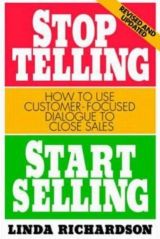


|
|
Stop Telling, Start Selling: How to Use Customer-Focused Dialogue to Close Sales (Paperback)
by Linda Richardson
| Category:
Selling skills, Sales, Marketing |
| Market price: ¥ 200.00
MSL price:
¥ 168.00
[ Shop incentives ]
|
| Stock:
Pre-order item, lead time 3-7 weeks upon payment [ COD term does not apply to pre-order items ] |
MSL rating:
 Good for Gifts Good for Gifts |
| If you want us to help you with the right titles you're looking for, or to make reading recommendations based on your needs, please contact our consultants. |

Detail |

Author |

Description |

Excerpt |

Reviews |
|
|
|
Author: Linda Richardson
Publisher: McGraw-Hill; 1 edition
Pub. in: September, 1998
ISBN: 0070525587
Pages: 272
Measurements: 8.9 x 5.8 x 0.7 inches
Origin of product: USA
Order code: BA01514
Other information: ISBN-13: 978-0070525580
|
|
Rate this product:
|
|
- MSL Picks -
In this revised edition of her best-seller, noted sales consultant Linda Richardson offers salespeople the tools they need to successfully use customer-focused, dialogue selling. Featuring real-world dialogue samples, helpful dos and don’ts, self-tests, checklists, and other useful tools, this guide offers insight on every aspect of face-to-face selling, from the initial introduction through the needs identification and the negotiation of terms and price to the successful close, with prime emphasis on the six critical skills necessary to the dialogue-driven sales call: presence, rapport building, questioning, listening, product positioning, and checking.
(From quoting Publisher, MSL)
|
|
Customers who bought this product also bought:
|
|
Linda Richardson is president of The Richardson Company in Philadelphia, a sales training firm with more than 160 clients, including Morgan Stanley, Johnson & Johnson, Aetna U.S. Healthcare, Citibank, Andersen Consulting, Tiffany & Co., Dell Computers, and Lucent Technologies. A member of the faculty of the prestigious Wharton Business School, she is the author of six books, including Selling by Phone and Sales CoachingMaking the Great Leap from Manager to Coach.
|
|
From publisher
In just a few short years since its publication, Stop Telling, Start Selling has become a leading textbook for sales training, used by more than 150 of the world's leading corporations. Why? Because it shows how to differentiate yourself, your product, and your organization in a hypercompetitive world of look-alike products.
The secret weapon is "dialogue selling" and this book shows you how to do it. "Much of what appears to be ' consultative selling' today is a masquerade for product selling," explains Linda Richardson, sales training consultant to many of the Fortune 500 and author of Selling by Phone and Sales Coaching. If you want to earn your customer's interest, trust and business STOP telling the customer about your product or service. Go beyond "customer focus." START a true customer dialogue.
In this newly revised and updated edition of Stop Telling, Start Selling Richardson teaches you the critical skills you need to revitalize your sales process, including how to:
- Understand your customer's political, personal, and business needs
- Position your message so it is important to your customer
- Unlearn manipulative tactics that can kill a sale early on
- Gather customer feedback to adjust your message as you go
- Maintain selling momentum and shorten the sales cycle
Stop Telling, Start Selling will help you truly listen to customers and put them first, that's what it takes to win the trustand the businessof today's sophisticated customers.
|
From a guest reviewer(MSL quoted), USA
<2008-10-28 00:00>
I can say the advice here is timeless: engage your customer, identify what your customer's needs are and position your product so that the customer realizes that your product meets their needs. Of course, if the customer doesn't need your product, then maybe you need to learn some of those "hard-ball sales" techniques (or find a better product!). No amount of customer empathy, listening, or product positioning will help you overcome a customer-product mismatch. Which brings me to a point: although Richardson argues against this, I think playing hardball has a place in negotiations; remember, the party you are negotiating with doesn't always have to feel warm and cozy inside in the process. A true persuader will know when to be soft and fluffy and when to apply the pressure.
Also, the whole paradigm-replacement languuage ("we are moving into a new age of selling...") is corny. The advice Richardson is giving is not new or revolutionary, as she claims. But she has succeeded in organizing a lot of really good sales principles in a clear and coherent way which can easily be appreciated by readers. |
|
|
|
|